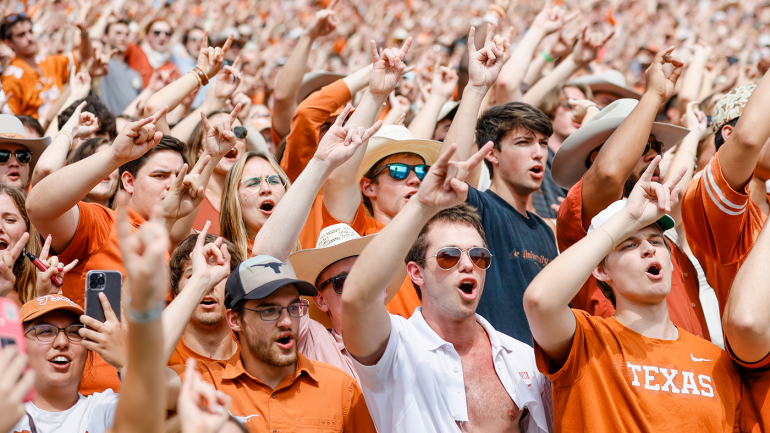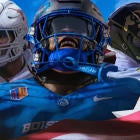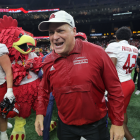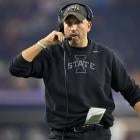
Seemingly everything college football was up in 2022: ticket prices, NIL riches, coaching salaries, your blood pressure if you were a Miami fan. Add attendance to the conga line of increases. In 2022, FBS attendance rose for the first time in eight years.
If you've paid attention to the sport's waning attendance figures, that's big deal. Official NCAA data shows that average FBS attendance increased 5% last season to 41,840 fans per game. While that sounds like a modest increase, it's significant as it indicates the second-highest per game rise (1,992) in history. (The NCAA has been keeping attendance figures since 1978.)
Not since 1982, when attendance rose an average of 9,068 per game from 1981, has there been a larger increase. The 2021 season marked the lowest average attendance (39,848) since that same year (1981).
The SEC is a good example of the somewhat-radical shift last season. The football-mad conference went from, in 2021, its lowest average attendance since 1999 to the fifth-largest figure in conference's history last season. The SEC led the country in attendance for the 24th consecutive year.
Just don't ask how or why. There may be some attributable explanations, but they aren't necessarily obvious. Attendance in 2021 declined for a record seventh consecutive year and for the ninth time in the last 10 years. (Not counting 2020 when the NCAA did not keep attendance data amid the COVID-19 pandemic season.)
Perhaps 2022 marked a further recovery from the ravages of pandemic, reflected in the stands. Two years removed from the COVID-19-shortened 2020 season, more fans were out and about. Perhaps it was turnarounds by non-traditional powers Kansas, Duke and Tulane (all up at least 48% from 2021).
Perhaps game day is becoming more "experiential." That's a code word in marketing circles for making the experience in the stands worthwhile, as close to the one at home as possible. For years, school and conference officials blamed the convenience of the 70-inch TV, the Barcalounger and the remote -- hello, channel surfing. Staying at home also saved on parking and concession costs.
Or perhaps 2022 was the beginning of a new era in consuming college football. While cable subscribers are down in general, watching the real thing in person isn't so bad after all.
- Tickets are a click away. They exist on your phone, no longer a place in your wallet. Buy, sale, trade, it's a separate market in itself. Convenience reigns.
- College fans remain a huge demographic that is generally more affluent than their peers in other sports. Rising prices have not deterred them. They have proved to be almost immune to inflation.
- The sale of alcohol is now a given in college stadiums rather than a novelty.
- It didn't hurt that teams that inhabit six of the top nine largest stadiums all went to major bowl games in 2022. National champion Georgia (ninth-largest stadium), Ohio State (third) and Michigan (first) all made the College Football Playoff.
"I think it's not the game that's more experiential," SEC commissioner Greg Sankey said. "It's the day and the weekend [that is] college football. There's always been a component of what happens around the game that's unique to college football."
It's all adding up to a better experience. Even the highest-resourced athletic department marketing division can't count on winning to sell tickets. But they can make the football encounter unique.
FBS attendance
| Season | Attendance | Change |
|---|---|---|
2014 | 44,603 | -1,068 |
2015 | 43,933 | -670 |
2016 | 43,612 | -321 |
2017 | 42,203 | -1,409 |
2018 | 41,856 | -347 |
2019 | 41,477 | -379 |
2021 | 39,848* | -1,629 |
| 2022 | 41,840^ | +1,992 |
* Lowest since 1981
^ Highest since 2018
Paciolan is an industry leader in mobile ticketing technology. The Irvine, California, based firm also specializes in marketing, fundraising and analytics. Paciolan has 80% of the Power Five as clients, so when it spots trends, well, that's what has president and CEO Kim Damron so excited.
In 2022, primary ticket sales were up 14% year over year. Ticket transfers were up 64%. And if you haven't experienced a ticketless system, you're not going to events. It is the standard these days.
"We saw record-breaking sales this past fall. With the advance of mobile, we've never seen this type of acceleration," Damron said.
It's an indication that, through the pandemic and inflation, football ticket sales have rebounded. It's also another indicator of that well-heeled college demographic.
"In economic downtowns, we don't see college take as big a hit as concerts or performing arts," Damron added. "We just don't. But the demand has been really, really loyal for college this past fall."
It certainly beats analyzing how to engage students and their phones. And the experience is about to get better. Forget cashless concession stands, the day is quickly coming when the game-day buying experience becomes … humanless.
A series of brew pubs and eateries built into San Diego State's new cozy Snapdragon Stadium almost threatens to make football a distraction. Not surprisingly, SDSU led the country in attendance increase (174%) in the debut season of Snapdragon.
Before games, Texas boasts Bevo Blvd, a burnt orange football Woodstock that hosts nationally known country acts and has its own pregame happy hour. Shockingly, 2022 marked the first season Texas surpassed average attendance of 100,000.
"Fans [in general] are treated really, really well," said Drew Martin, Texas' senior associate executive for external affairs. "It's not the old in-line-for-45-minutes-for-the-bathoroom-or-get-a-hot-dog. It's such a better experience now."
Attendance changes by conference
| Conference | Avg. Attendance '22 | % Change YOY | Notes |
|---|---|---|---|
SEC | 76,667 | +6.19 | Highest since '17 |
Big Ten | 67,295 | +3.13 | Highest since '13 |
Big 12 | 59,783 | +8.66 | Highest since '11 |
| ACC | 48,714 | +14.35 | Highest since '18 |
| Pac-12 | 44,458 | +1.35 | 2nd-lowest ever |
| Independents | 33,886 | +5.41 | 2nd-lowest since '01 |
AAC | 28,253 | -1.18 | Lowest ever* |
MWC | 22,611 | +5.65 | 2nd-lowest ever* |
| C-USA | 19,346 | +11.90 | Highest since '16 |
| Sun Belt | 19,174 | +4.14 | Highest since '13 |
MAC | 14,261 | -18.30 | Lowest since '93 |
* Since inception of the American (2013), Mountain West (1999)
For the first time since the Big 12 debuted in 1996, all of the current Power Five conferences had attendance increases. The ACC led the way with an overall 14.35% rise (6,115 per game). That was quite a rebound from league's the lowest average attendance since 1991 (42,599 in 2021). The 48,714 average last season was the conference's highest since 2018.
Two programs with new coaches led the way. Duke with Mike Elko won at least nine for only the second time since 1941. The Blue Devils had the second-highest increase among Power Five (58.9%). Even though the preseason hype didn't match the first-year result, Miami with Mario Cristobal had the third-biggest ACC increase, up 25% to 54,964.
"We needed to prioritize football," ACC commissioner Jim Phillips told CBS Sports.
That was part of the initiative Phillips pushed in calling for a 24/7, 365 review of ACC sports. In the basketball-conscious league, all 14 spring football games were telecast for the first time. There were dedicated recruiting shows on the ACC Network on both signing days. That emphasis was needed even with Clemson becoming an ACC dynasty with two national championships and seven conference titles since 2015.
"It's a reminder of where our country has stated it's going to spend its most time," Phillips said. "... The popularity [of football] continues but as you known we have to do some things to protect it. Health and safety is paramount."
At least that's the hope of the NCAA Football Rules Committee, which proposed last week at least one sweeping change: the clock will keep running after first downs, chopping off the number of plays per game. The nation's No. 2 sport will be played in a tighter, more fan-friendly window.
That helps fan engagement, too.
The Big 12 had the second-biggest gain among the Power Five (8.66%, 4,766 per game). That was after 2021's average of 55,017 was the lowest since 2000. Not surprisingly, Texas led the way with the country's eighth-biggest stadium.
It helped that the Longhorns had Alabama at home in Week 2. With the jump to the SEC now resolved, season ticket renewals are up 10%, Martin said. That's coming off a season of record season ticket sales (64,000). Martin also noted excitement created not only by the SEC move but the arrival of five-star quarterback Arch Manning.
"ADs and departments are really taking a look at -- over time, what's driving people to come spend five, six, seven hours on campus and a few hundred dollars," Martin added. "Having said that, there is a lot of attention [nationally] on the Big Ten move, the SEC move. It invigorates a lot of the conversation around college sports."
Little old Kansas had the biggest gain, by percentage, among Power Five schools (63% to 43,706 per game). As the Jayhawks rolled to a 5-0 start, they became a national story going to a bowl for the first time since 2009.
The SEC went from its lowest average attendance in 22 years (72,195 in 2021) to 76,667 in 2022. That marked an increase of 6.2% (4,472 per game). The 2022 average was only 1,964 short of the conference's all-time record (78,630 in 2015).
A year after nine of the SEC's 14 teams experienced attendance declines, five SEC programs experienced double-digit percentage increases in 2022. Ole Miss, Arkansas, Vanderbilt, Tennessee and Missouri all were up at least 10.8%. That's not counting South Carolina, which jumped more than 6,000 per game (8.68%) in Shame Beamer's second season.
The Big Ten (+3.13%) and Pac-12 (+1.35%) rounded out the Power Five. The Big Ten's average of 67,295 was its highest since 2013. The Pac-12 had declined eight straight years. It was up a fraction, only 593 fans per game in 2022.
Attendance superlatives
- The 2022 national average still sits 7,123 per game behind the all-time record of 46,971 in 2008. The 2021 average of 39,848 was the lowest since 1981 (34,621). National attendance increased for a record 12 consecutive years from 1997-2008.
- Why the 2022 gain is even more impressive: Since 1988, FBS membership has grown 26% from 104 to 131 schools. Those 27 newcomers are typically smaller stadiums that drag the average down.
- The top five seasons in FBS total attendance have come since 2010. The record of 38,135,118 was set in 2013. In 2022, total attendance rose for the third time in the last four years to 37,237,555.
- Not surprisingly, the top 50 crowds from 2022 were posted exclusively in Big 12, SEC and Big Ten stadiums. Those crowds were isolated to only seven stadiums: Michigan, Penn State, Texas A&M, Ohio State, Texas, LSU and Alabama. There was no surprise that Michigan -- with the nation's largest capacity -- had the top six crowds and eight of the top nine. Michigan led the country in attendance for the sixth year in a row and 22nd time in the last 23 season.
- Among the Group of Five, the embattled Conference USA had the largest gain up 11.9% to 19,346 per game. That was in the same year the league was almost ripped apart by realignment.
- The MAC had the largest decline of any FBS conference, down 18.3% to an FBS-low 14,261 per game.
















